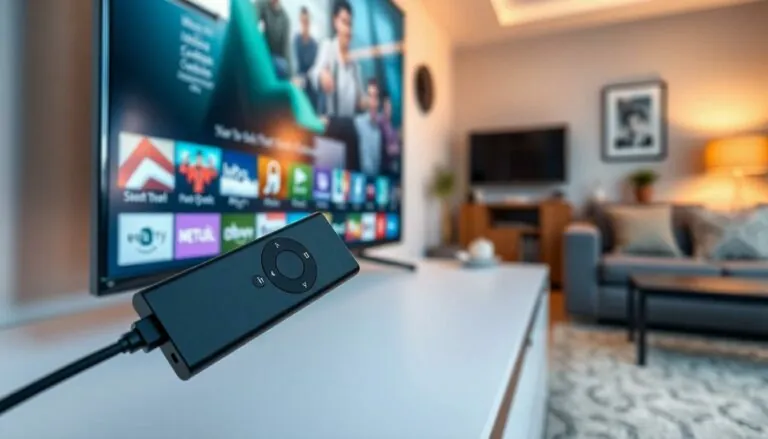In a world where gadgets seem to multiply like rabbits, the art of consumer electronics product design has become a thrilling game of innovation. It’s not just about making things look pretty; it’s about creating experiences that make users wonder how they ever lived without them. From sleek smartphones to smart fridges that can judge your midnight snacking habits, design plays a crucial role in making technology accessible and, dare we say, lovable.
As designers dive into the realm of consumer electronics, they juggle aesthetics, functionality, and user experience like a circus performer with flaming torches. The challenge? Crafting products that not only catch the eye but also fit seamlessly into everyday life. So buckle up as we explore the fascinating world of consumer electronics product design, where creativity meets practicality and every device has a story waiting to be told.
Table of Contents
ToggleOverview of Consumer Electronics Product Design
Consumer electronics product design encompasses several key elements that transform technological concepts into compelling products. Designers focus on user needs, creating devices that are both functional and visually appealing. They analyze market trends to ensure products meet current demands while maintaining a unique identity.
Functionality plays a pivotal role in the design process. Designers consider user interaction to enhance experiences with features tailored to specific audiences. User-centered design principles guide this process, ensuring that products are intuitive and easy to use.
Aesthetic considerations also shape product design. Visual appeal attracts consumers, making their purchasing decisions simpler. Designers balance form and function, ensuring that each product stands out in the crowded marketplace.
Sustainability has gained significant attention in recent years. Many designers prioritize eco-friendly materials and energy-efficient components. This focus not only appeals to environmentally conscious consumers but also aligns with industry regulations aimed at reducing electronic waste.
Collaboration among engineers, marketers, and designers is crucial. Cross-functional teams work together to bring innovative ideas to life, each member contributing specialized expertise. This synergy enhances the overall design quality and promotes efficient production processes.
Prototyping serves as a vital stage in the design process. Creating prototypes allows designers to test functionalities and gather user feedback before mass production. This iterative approach leads to refined products that meet consumer expectations.
By integrating these aspects, consumer electronics product design continually evolves to create devices that enhance daily life. Each new product represents a blend of art and science, reflecting the complexity and excitement of modern technology.
Key Principles of Effective Design

Effective design in consumer electronics revolves around several key principles that enhance usability and appeal.
User-Centered Design
User-centered design focuses on understanding the needs and preferences of end-users. Designers gather insights through research and usability testing. Intuitive interfaces streamline interactions. They prioritize features that simplify tasks, ensuring functionality aligns with user expectations. Different user groups require tailored solutions, thus creating variations to cater to distinct preferences is crucial. Adaptive designs allow for accessibility across diverse demographics. Intensive feedback loops from users lead to constant improvements, converting ideas into practical applications.
Aesthetic Considerations
Aesthetic considerations significantly impact consumer choices. Visual appeal attracts initial attention, influencing purchasing decisions. Designers explore color, shape, and texture to evoke specific emotions. A mindful balance between form and function yields a pleasant user experience. Iconic designs can establish a brand’s identity, allowing products to stand out in a competitive market. Trends shift rapidly, thus staying current with aesthetic preferences is essential. Unique design elements often create a memorable experience that encourages customer loyalty.
Sustainability in Design
Sustainability in design increasingly shapes consumer electronics. Eco-friendly materials are imperative, reflecting a growing demand for responsible production. Designers incorporate energy-efficient components to minimize environmental impact. Sustainable practices not only meet regulations but also resonate with environmentally conscious consumers. Lifecycle assessments guide decisions, ensuring products remain eco-friendly from creation to disposal. Brands that embrace sustainable design often build stronger relationships with their audience. In competitive markets, sustainability can distinguish a product, enhancing its overall appeal.
Trends in Consumer Electronics Product Design
The landscape of consumer electronics product design shows dynamic transformations influenced by technological advancements and consumer preferences. Key trends drive the current design ethos, focusing on user experiences and innovative features.
Smart Technology Integration
Smart technology integration enhances functionality in consumer electronics. Designers increasingly incorporate artificial intelligence, Internet of Things connectivity, and automation features into devices. These advancements allow products to adapt and respond to user behavior, making daily tasks more efficient. For example, smart home devices can learn user patterns, optimizing energy usage. This trend not only improves convenience but also fosters an interactive relationship between consumers and their devices.
Minimalist Designs
Minimalist designs resonate deeply with consumers seeking simplicity. A focus on clean lines and a reduction of unnecessary features characterize this aesthetic. Devices with minimalistic approaches offer sleek appearances while ensuring usability remains a priority. For instance, smartphones often showcase fewer physical buttons, emphasizing touchscreen functions instead. Such designs create an intuitive user experience that appeals to modern sensibilities.
Customization Options
Customization options empower consumers to personalize their devices. Brands increasingly offer features that allow users to tailor aesthetics and functionalities according to individual preferences. Configurable settings, interchangeable components, and a variety of colors facilitate user expression. Customizable interfaces further enhance this personalization. As a result, devices not only resonate on a functional level but also connect with consumers emotionally.
Challenges in Consumer Electronics Product Design
Consumer electronics product design faces several notable challenges, which impact the overall development process. Staying ahead of technological trends requires constant adaptation to meet changing demands.
Rapid Technological Changes
Rapid advancements in technology create a constantly shifting landscape for designers. Designers often need to embrace new materials, software, and hardware capabilities. Keeping up with these trends proves essential for creating products that remain competitive. For instance, the rise of artificial intelligence has transformed user interface expectations, influencing how devices interact with consumers. Designers must also forecast future technological shifts, ensuring products stay relevant in an increasingly fast-paced market.
Balancing Functionality and Style
Balancing functionality and style remains a significant challenge in product design. Functionality must cater to user needs while offering an intuitive experience. Designers face pressure to create visually appealing products that resonate with consumers. Competing on aesthetics alone can detract from usability, leading to poor user experiences. Additionally, brands strive for a unique identity in a crowded market, so distinguishing between functionality and style is crucial for long-term success. Prioritizing both aspects often leads to innovative design solutions that enhance overall device appeal.
Consumer electronics product design stands at the intersection of innovation and user experience. As designers navigate the complexities of functionality and aesthetics they shape devices that resonate with consumers on multiple levels. The commitment to sustainability and user-centered principles not only meets market demands but also fosters a sense of responsibility towards the environment.
With rapid technological advancements and changing consumer preferences the field remains dynamic. Designers must continue to adapt while embracing trends like smart technology and customization. This ongoing evolution ensures that each product tells its own unique story enhancing everyday life and solidifying the bond between users and their devices.





